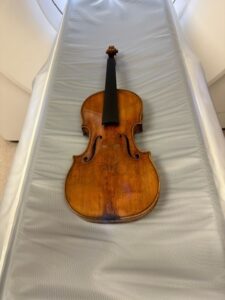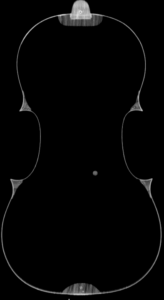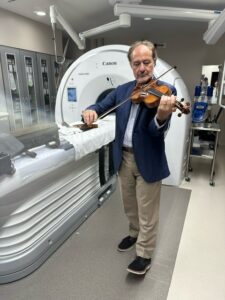
Imagine holding a piece of history in your hands — a violin crafted over 300 years ago by the legendary Antonio Stradivari. Now imagine peering so deeply inside that you can count the rings on the wood pieces used. This is exactly what our radiologists and research staff experienced when they had the rare opportunity to scan a Stradivarius violin.
Antonio Stradivari, a master luthier from Cremona, Italy, crafted an estimated 1,100 instruments during his 71-year career. Only about 650 of these instruments have survived, including 450 to 512 violins. Stradivarius instruments are incredibly valuable, with some worth millions of dollars. For instance, the Lady Blunt Stradivarius violin sold for a record $15.9 million in 2011.
But why are these violins so sought after? Stradivarius instruments are renowned for their fine symmetry, beautiful details, and unique tonal qualities. Theories about their exceptional sound include the special density of the wood used during the Little Ice Age and the varnish or chemical treatments applied to the wood.

The condition of a Stradivarius violin is a critical factor in determining its value. Even the most expertly crafted violins are not immune to the ravages of time. These instruments are particularly susceptible to low humidity, which can cause the wood to crack and the traditional hide glue to become brittle, leading to open seams.

The violin scanned at UW–Madison had undergone repairs in the 1800s, but the specifics of these repairs were unknown. This is where the expertise of the UW Department of Radiology team came into play. The CT scans provided a non-invasive approach to viewing the inner construction of the violin, revealing details that cannot be seen on the surface.
Gabriel Ben-Dashan is a former professional musician and the owner and director of Bein & Fushi, Inc., a firm specializing in the sales and restoration of fine and rare stringed instruments. He reached out to our team about having the violin scanned. Fred Lee, MD – an amateur violinist himself – was happy to oblige. He along with Guiseppe Toia, MD; Tim Szczykutowicz, PhD; Timothy Ziemlewicz, MD; fellow Troy Tenbrunsel, MD; as well as research analysts Rachel Bladorn and Kelsey Schluter used multiple scanners, including the Generation 3 Silicon-Based Photon Counting Scanner. Dr. Szczykutowicz developed the protocols for calculating how the scans could be accomplished.

While the scans may not unlock all the secrets of Stradivari’s craftsmanship, they provide a deeper appreciation for the complexity and beauty of these instruments. It was a reminder of the intersection between art and science, and the privilege of contributing to the preservation of a priceless artifact.
